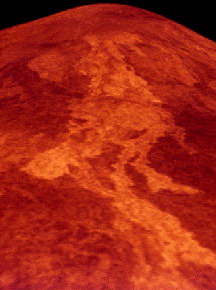Click on image for full size
Image courtesy of Julia Vishnevets
Related links:
Arctic Cultures
There are people of different cultures and backgrounds who live in the Arctic region. Read on to learn more about two of these cultures.
Inuit
The Inuit are the native cultures that continue to live on coastal areas of Arctic tundra in Canada, Alaska (USA), Siberia (Russia), and Greenland. Over this broad area there are many different groups of people. Some share common ancestors, others probably do not, but most have similar ways of living in the Arctic. Inuit traditionally hunted for seals, whales, polar bears, caribou, birds and other animals from the ocean and the tundra. Inuit people invented the kayak and used these small boats to hunt for Arctic marine animals. Because of a great respect for these animals, Inuit have traditional customs that must be followed during a hunt. Inuit myths were inspired by the environment that they lived within including the magical appearance of the aurora in the night sky, the long dark winters, and the icy Arctic Ocean. Explore more about Inuit culture by visiting the links below.
Norse
Norse people were originally from Scandinavian countries. During the Middle Ages, between approximately 850 and 1066 AD, groups of Norse explorers and warriors called Vikings raided and colonized other regions within and near the Arctic such as Greenland, Iceland, and northern Russia (as well as warmer, lower latitude locations too). Today, many people living in these countries are descendants of the Norse people.
The Norse were excellent boat builders, crafting vessels out of wood called longships, which could travel across large expanses of ocean. There were many oars along the sides of the boat and often one square sail. Vikings would row the oars and wind would fill the sail, propelling the boat. The Norse people, including the Vikings, were known to be excellent storytellers. Explore some of the myths from the Norse people in the links below.
Norse Myths
![]() The Earth: Midgard
The Earth: Midgard
![]() The Sea: Aegir
The Sea: Aegir
![]() The winds: Njord
The winds: Njord
![]() The Thunder: Thor
The Thunder: Thor
![]() The sky: Tyr
The sky: Tyr
![]() The Sky: Odin
The Sky: Odin
![]() The Aurora: Freya
The Aurora: Freya
![]() The Northern Lights: The Valkiries
The Northern Lights: The Valkiries
![]() The Sun: Freyr
The Sun: Freyr
![]() The Planet Venus: Sif
The Planet Venus: Sif
![]() The Milky Way: Bifrost
The Milky Way: Bifrost
![]() The Norse Family Tree
The Norse Family Tree
Inuit Myths
![]() The Sun: Malina
The Sun: Malina
![]() The Moon: Anningan
The Moon: Anningan
![]() The Sea: Sedna
The Sea: Sedna















